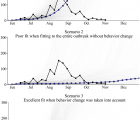Introduction: Uganda has reported eight outbreaks caused by filoviruses between 2000 to 2016, more than any other country in the world. We used species distribution modeling to predict where filovirus outbreaks are likely to occur in Uganda to help in epidemic preparedness and surveillance.
Methods: The MaxEnt software, a machine learning modeling approach that uses presence-only data was used to establish filovirus – environmental relationships. Presence-only data for filovirus outbreaks were collected from the field and online sources. Environmental covariates from Africlim that have been downscaled to a nominal resolution of 1km x 1km were used. The final model gave the relative probability of the presence of filoviruses in the study area obtained from an average of 100 bootstrap runs. Model evaluation was carried out using Receiver Operating Characteristic (ROC) plots. Maps were created using ArcGIS 10.3 mapping software.
Results: We showed that bats as potential reservoirs of filoviruses are distributed all over Uganda. Potential outbreak areas for Ebola and Marburg virus disease were predicted in West, Southwest and Central parts of Uganda, which corresponds to bat distribution and previous filovirus outbreaks areas. Additionally, the models predicted the Eastern Uganda region and other areas that have not reported outbreaks before to be potential outbreak hotspots. Rainfall variables were the most important in influencing model prediction compared to temperature variables.
Conclusions: Despite the limitations in the prediction model due to lack of adequate sample records for outbreaks, especially for the Marburg cases, the models provided risk maps to the Uganda surveillance system on filovirus outbreaks. The risk maps will aid in identifying areas to focus the filovirus surveillance for early detection and responses hence curtailing a pandemic. The results from this study also confirm previous findings that suggest that filoviruses are mainly limited by the amount of rainfall received in an area.

